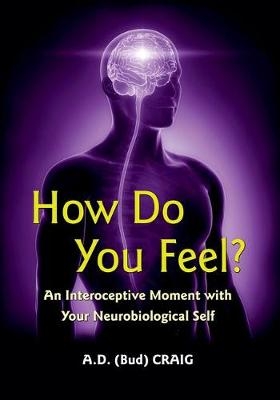
How Do You Feel?
Princeton University Press (Verlag)
978-0-691-15676-7 (ISBN)
- Titel z.Zt. nicht lieferbar
- Versandkostenfrei innerhalb Deutschlands
- Auch auf Rechnung
- Verfügbarkeit in der Filiale vor Ort prüfen
- Artikel merken
This book will fundamentally alter the way that neuroscientists and psychologists categorize sensations and understand the origins and significance of human feelings.
A. D. (Bud) Craig is the Atkinson Research Scientist at the Barrow Neurological Institute, and is appointed as an adjunct research professor of cellular and molecular medicine at the University of Arizona College of Medicine, and an adjunct research professor of psychology at Arizona State University.
List of Figures and Plates ix List of Boxes xi Preface xiii 1AN INTRODUCTION TO INTEROCEPTION 1 2FEELINGS FROM THE BODY VIEWED AS EMOTIONS Ideas from the lamina I projection map that add to the textbooks 16 An overview of the map 16 The central neural substrates for homeostasis 19 Textbook knowledge regarding touch 23 Textbook knowledge regarding pain and temperature 28 Irritating incongruities 31 Identification of the thermosensory pathway 33 Recognizing that temperature sensation is part of interoception 38 Viewing a thermosensory feeling as a homeostatic emotion 42 Thermal sensations become subjective feelings 45 Emergent ideas about feelings, moments, music, and time 46 Bivalent emotions in bicameral brains 50 3THE ORIGIN OF THE INTEROCEPTIVE PATHWAY Homeostatic sensory fibers and the interoceptive dorsal horn 54 Finding lamina I spinothalamic neurons 55 Lamina I spinothalamic neurons are "labeled lines 62 Anomalous characteristics point to a new direction 71 Integrated lamina I activity generates thermoregulatory pain: the thermal grill 74 Identifying lamina I projections to autonomic neurons 82 Demonstrating that lamina I subserves homeostasis 90 The identification of homeostatic small-diameter sensory fibers 94 The development of the interoceptive dorsal horn 97 The interoceptive dorsal horn subserves homeostasis 101 The evolutionary origin of interoceptive and exteroceptive neurons 103 The homeostatic sensory system provides crucial vasoreceptive feedback 106 4INTEROCEPTION AND HOMEOSTASIS Lamina I terminations at cardiorespiratory sites in the brainstem 111 An overview of lamina I projections to the brainstem 112 Lamina I terminations in the lower brainstem (medulla) 115 Lamina I terminations in the middle brainstem (pons) 118 Lamina I terminations in the parabrachial nucleus 119 Lamina I terminations in the periaqueductal gray (upper brainstem) 124 Summary 129 5THE INTEROCEPTIVE PATHWAY TO THE INSULAR CORTEX Lamina I spinothalamic input to the thalamus and cortex in primates 130 My introduction to functional neuroanatomy 131 The significance of somatotopic organization 133 The lateral spinothalamic tract 134 Finding Waldo 135 The functional anatomical characteristics of the VMpo in the macaque monkey 139 The projection from the VMpo to the dorsal posterior insula in the macaque monkey 145 The organization of the dorsal posterior insula in the macaque monkey 150 The interoceptive pathway 155 The human VMpo 160 The human dorsal posterior insula 166 The human interoceptive cortex 170 Interoceptive touch 173 Summary, and an interoceptive perspective on cortical gyrification 175 6BODILY FEELINGS EMERGE IN THE INSULAR CORTEX Interoceptive integration generates the feeling of being alive 182 The structure of the insular cortex 183 Posterior-to-mid-to-anterior processing of interoceptive activity 185 Multimodal integration in the mid-insula 188 Feelings from the body emerge first in the mid-insula 191 Homeostatic sentience 194 Interoceptive integration improves energy efficiency 197 The model of interoceptive integration and the generalization of feelings 199 Interoceptive feelings come to awareness in the anterior insula 203 Emotional feelings emerge and come to awareness in the anterior insula 206 The embodiment of emotional feelings 209 7FEELINGS ABOUT THOUGHTS, TIME, AND ME Awareness emerges in the anterior insular cortex 216 The AIC is activated during cognitive activity 219 The model: Integration of cognitive feelings 221 Evidence that awareness is engendered in the AIC 223 Evidence that the AIC supports feelings about time 226 The model: Cinemascopic integration of moments of time 228 The model: The structural basis of awareness 235 The role of the AIC in the control of network activity 243 Evidence that the AIC is crucial for fluid intelligence 247 Evidence that the AIC optimizes energy utilization 249 Individual variability and maturation 251 Distorted feelings produce mental illness 254 8FEELINGS AND EMOTIONS ON BOTH SIDES OF THE BRAIN The asymmetric forebrain 257 Ethological evidence of forebrain asymmetry 260 Neuroanatomical evidence of forebrain and AIC asymmetry 262 Clinical evidence of forebrain and AIC asymmetry 263 Physiological evidence of forebrain and AIC asymmetry 265 Psychophysiological evidence of forebrain and AIC asymmetry 267 Two recent reviews uncover asymmetric activation of the amygdala and the AIC 270 The alignment of autonomic, behavioral, and affective control 272 Opponent inhibition 274 Specialization and balance 275 And something curious 277 9A FEW MORE THOUGHTS ABOUT FEELINGS Graded sentience and tail-wagging in dogs 280 A quick review 280 Scaling up homeostatic sentience 285 Graded sentience 289 Feelings in dogs 293 How about Watson? 295 Acknowledgments 297 Abbreviations 299 Glossary 301 Reference List 309 Illustration Credits 337 Index 339
| Zusatzinfo | 7 line illus. |
|---|---|
| Verlagsort | New Jersey |
| Sprache | englisch |
| Maße | 178 x 254 mm |
| Gewicht | 851 g |
| Themenwelt | Geisteswissenschaften ► Psychologie ► Allgemeine Psychologie |
| Geisteswissenschaften ► Psychologie ► Verhaltenstherapie | |
| Medizin / Pharmazie ► Medizinische Fachgebiete ► Neurologie | |
| Naturwissenschaften ► Biologie ► Humanbiologie | |
| Naturwissenschaften ► Biologie ► Zoologie | |
| ISBN-10 | 0-691-15676-X / 069115676X |
| ISBN-13 | 978-0-691-15676-7 / 9780691156767 |
| Zustand | Neuware |
| Haben Sie eine Frage zum Produkt? |
aus dem Bereich


